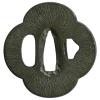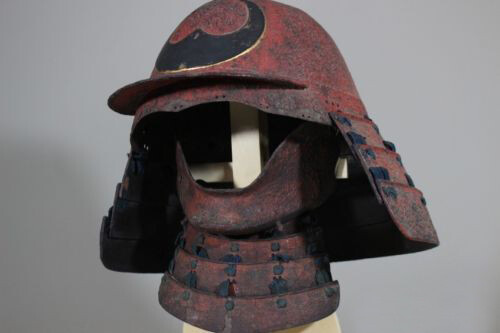-
Posts
277 -
Joined
-
Last visited
-
Days Won
1
Everything posted by Iekatsu
-
Luc, my point was that it is not an exclusive trait, there any many Koboshi from many different smiths that have three rows of rivets on the front plate.
-
The Dou, all alterations aside is actually quite interesting, a relatively uncommon form, these Dou are essentially munition/Okashi grade items. The reason it is signed is because the Iwai were often tasked with and responsible for repairing and refurbishing Okashi armour in the Edo period, this is also why there are so many examples of mediocre armour bearing the Iwai inscriptions. Below is an example of similar style of Dou, and another that has an Iwai inscription that sold recently on yahoo. These examples are more indicative of what the Dou originally would have looked like.
-
The lacquer damage is consistent with the holes being drilled after it was lacquered, generally the surface would be lacquered and then the fittings added (this would be true even if it was refurbished in period). That fact that no lacquer remains intact around any of the fittings, that some of the fittings punch though part of the inscription, that there is evidence of other post period modifications all indicate that there was likely never any fittings originally and that the current fittings were likely added post period.
-
There are some serious red flags here, it is quite clear that decorative plates and fittings have been added post period. This was originally sold as part of a "set", which was cobbled together from Edo and Showa period components. The Dou has been vandalised, this is unscrupulous behaviour which needs to be condemned. https://www.catawiki.com/es/l/47534071-yoroi-cuero-hierro-forjado-seda-japans-samurai-armor-kyogoku-takatsugu-gesigneerd-1590-japon-siglo-xvi
-
While this is very true, generally the changes were made to update or repair an item, and these changes/repairs often reflected the styles and conventions of the period the alterations were made. In this case if there were modifications it would likely reflect Edo conventions, which are not really represented in this example (other than the Shikoro). The shape of the Mabizashi is actually quite typical for this period, particularly for Ko-Boshi. The Haraidate-dai is definitely atypical, but is well within the scope for the period in question. There was significant experimentation with different shapes and configurations, by the Edo period Haraidate-dai for the most part fall into standardized patterns.
-
Luc, What makes you think the Mabizashi and Haraidate-dai may have been replaced?
-
I actually think the Hachi dates to the late Muromachi period and not the early Edo for the following reasons. The rivets are very fine, quite close to the Suji and not placed with precision. The Tehen is quite small and the Tehen kanamono is very simple, this is very much in line with Ko-boshi of the late Muromachi, where the Tehen was often vestigial. The shape and form of the Mabizashi is in-line with comparative examples from the period and the unconventional shape of Haraidate-dai is consistent with the experimentation taking place in this period.
-
I totally agree with Anthony, to add further points, three rows of rivets on the front plate is a common convention for Ko-boshi kabuto and not unique to Bamen at all and the placement and shape of the rivets is not consistent with Bamen work.
-
What does everyone think about it potentially being Gimei? For me there are several red flags: 1. There is doubt that the smith ever existed. 2. There are no other examples for comparison. 3. The work does not appear to align with the working dates of the smith.
-
I had the same thoughts as Ian. Stylistically it does not really align with the working dates listed either.
-
Hello Jason, If its your first peice it might be a good idea to look at just picking up a kabuto, in the same price bracket you could get something nice and will have less problems with condition issues.
-
As the others have said, its a reproduction, late Showa period, potentially even later. The quality of the "Menpo" is significantly worse and not even close to the real thing.
-
Id say it's Momoyama-Early Edo, a relatively low end piece. At some point it was heavily corroded, which did quite a bit of damage and was later cleaned and stabilised.
-
Tom, This style of kabuto is relatively common, as Uwe mentioned they were mass produced for Okashi-Gusoku (loan Armour) in Kaga and date to the Edo period. The Dou are far less common though, I have seen a couple of partial sets of these Okashi-Gusoku, they tend to be comprised of a simple 6 plate kabuto, Tsubame Hanbo, Hotoke Dou and simple Sangu with rounded plates. Each element is finished in the same lacquer as the helmet and Dou and the Ie-ji (baking fabric) tends to be light blue or tan Asa (hemp) with Mid blue trim. I have attached a couple of images below for reference, note the Haidate (Thigh guards) and Suneate (Shin guards) do not belong to the set. The damage to the Hachi is likely just from neglect, it appears to have rusted through. While not high end items or in good condition there are things to learn from such items, I hope they bring you joy.
-
Mark, It's a decent looking Ressei me-no-shita men, Nara style. These are relatively common, yours likely dates to mid-late Edo period. The condition is not bad, but there could be rust forming under the cracked lacquer. Uwe did a good write up of the style in the following thread if you want some more information.
-
Ukebari were most likely expendable in period and were likely replaced multiple times over the helmets lifetime, but that does not change the fact that intact Ukebari are part of the kabuto and should be preserved with it where ever possible. How many period Ukebari in original condition do you think will be around to study in 100 years if these practices continue?
-
I agree with Uwe, the Hachi looks like it could have some age. Could we please get some images of the front, rear and underside of the Hachi/kabuto and the inside of the Menpo?
-
If someone wants to study the construction methods there are plently bare Hachi, or kabuto with compromised Ukebari that can be purchased, I am appalled that ranking members of the Japanese armour society are casually advocating vandalism, we are after all only temporary custodians of these objects.
-
Ruben, The images are a little rough, but I would say it is the same armour that was posted by Luc earlier in the thread.
-
The above is an armour model from the showa period, it has no bearing on the topic. But in the same search the other components for the armour appear to match.
-
A common practice does not mean its a good practice, it's generally done with very little care, primarily to facilitate sale. Given that there is a large portion of signed kabuto that do not have windows in the Ukebari it was clearly not a universal practice. A borescope can be inserted through the Tehen to look into the interior without damaging the Ukebari.
-
I don't think we should be condoning the practice of cutting windows in Ukebari.
-
Yas, The work was likey massed produced, given the number of extant examples. The same style of Tsuba are also found in Maru-gata and there are also different motifs and bespoke custom peices that appear to come from the same workshop. As for the age, dating anything pre Edo is pretty tricky as there are so few dateable reference points, that said the Kantei points appear to be consistent with the attribution. All the best, Thomas
-
Yas, The Tsuba you posted with the fox/squirrel and wave motif are not modern, they are early San-mai and utilise stamped plates in their construction (quite often from the same dies). The marks highlighted on the Seppa-dai are actually rivets that hold the plates in place, this variety was likely produced in a single workshop, given the consistency in technique and construction. They are generally attributed to late Muromachi-Momoyama period. Take a look at the following thread for more examples: All the best, Thomas











